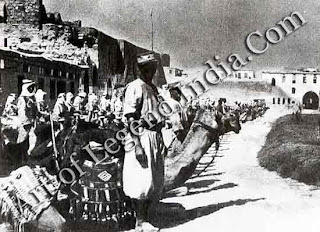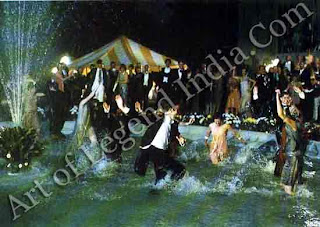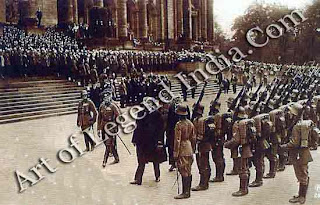A Year in the Life 1925
 In
1925, while Mire and other Surrealists were putting on their first exhibition
in Paris, European peace seemed secure and trust was placed in the authority of
the League of Nations. But, during this year, Adolf Hitler published his
belligerent ideas in Mein Kampf which were ultimately to lead to War.
In
1925, while Mire and other Surrealists were putting on their first exhibition
in Paris, European peace seemed secure and trust was placed in the authority of
the League of Nations. But, during this year, Adolf Hitler published his
belligerent ideas in Mein Kampf which were ultimately to lead to War.
At the
first Surrealist Exhibition, held in Paris in 1925, the works of Mir&
Picasso and Ernst asserted the primacy of the unconscious whereas in world
affairs it seemed that reason might yet triumph. Germany, burdened by
reparations and plunged into chaos by hyper-inflation, had been rescued by the
1924 Dawes Plan and, with the help of huge American loans, was making an
economic recovery. Under the guidance of Gustav Stresemann, she also began to
be accepted by her wartime enemies.
However,
international security was not easily achieved. The Geneva Protocol, put before
the League of Nations in October 1924 by the British Labour Prime Minister
Ramsey MacDonald, proposed by system of arbitration to end conflicts between
nations. But it foundered on opposition from the Dominions; a French Canadian
politician pointed out complacently that, 'We live in a fireproof house, far
from inflammable materials.' In March 1925, Stanley Baldwin's newly elected
Conservative government rejected the Protocol, which was then dropped.
 THE LEAGUE OF NATIONS
THE LEAGUE OF NATIONS
Nonetheless,
the League of Nations scored some real successes in 1925. Arrangements were
made to control the opium trade and arms dealing; and when Greece attacked
Bulgaria after border clashes, the League intervened to settle the dispute and
extracted a fine from the Greeks. In Europe, the failure of the Geneva Protocol
was largely made good as a result of German proposals which were elaborated
into the Locarno treaties. The European powers collectively guaranteed
Germany's existing borders with most of her neighbours, and this, together with
a set of arbitration agreements and the formation of Franco-Polish and
Franco-Czechoslovak alliances, quieted French fears and seemed to ensure peace
in Europe. The new atmosphere of international conciliation lasted until the
1929 Depression disrupted the entire political and economic system.
 Germany's
Weimar Republic was actually strengthened by a presidential election won by
Paul von Hindenburg, the most prestigious wartime military leader. Though a
conservative and monarchist, Hindenburg proved willing to accept republican
institutions and so conferred respectability on them. The Nazi-backed
candidate, General Ludendorff, polled a derisory 210,000 votes. Peace and
returning prosperity seemed to have dashed the hopes of agitators such as the
Nazi leader Adolf Hitler. He was still on parole after his early release from
prison (he had received a five-year sentence for his part in the 1923 'Beer
Hall putsch' in Bavaria). The first volume of his book Mein Kampf was published
in the summer of 1925 and set out explicitly the policies he was later to
implement as Fuehrer of the Third Reich. Around 10,000 copies were sold in all,
mainly to the Party faithful.
Germany's
Weimar Republic was actually strengthened by a presidential election won by
Paul von Hindenburg, the most prestigious wartime military leader. Though a
conservative and monarchist, Hindenburg proved willing to accept republican
institutions and so conferred respectability on them. The Nazi-backed
candidate, General Ludendorff, polled a derisory 210,000 votes. Peace and
returning prosperity seemed to have dashed the hopes of agitators such as the
Nazi leader Adolf Hitler. He was still on parole after his early release from
prison (he had received a five-year sentence for his part in the 1923 'Beer
Hall putsch' in Bavaria). The first volume of his book Mein Kampf was published
in the summer of 1925 and set out explicitly the policies he was later to
implement as Fuehrer of the Third Reich. Around 10,000 copies were sold in all,
mainly to the Party faithful.

The
year 1925 was also when Mrs. Nellie Ross of Wyoming became the first woman
state governor in the USA. Skirts were being worn just below the knee and were
getting shorter. In Turkey, Mustapha Kemal banned polygamy and the wearing of
the fez. At the celebrated 'Monkey Trial' in Tennessee, John A. Scopes was
indicted for violating state laws by teaching Darwin's Theory of Evolution.
On the
cultural front, 1925 saw the publication of Scott Fitzgerald's The Great
Gatsby, John Dos Passos's Manhattan Transfer and Virginia Woolf's Mrs. Dalloway.
The Trial, an unfinished novel by Franz Kafka, who had died in 1924, was also
published. Fortunately for posterity, Kafka's literary executor, Max Brod,
decided to ignore the writer's request that these and other unpublished works
should be destroyed. The architect Walter Gropius began his great Bauhaus
buildings at Dessau, while in Paris; an Exhibition of Decorative Arts launched
a style that could hardly have been more different in spirit from Surrealism
hard-edged, modernistic Art Deco.
Writer
– Marshall Cavendish
 In
1925, while Mire and other Surrealists were putting on their first exhibition
in Paris, European peace seemed secure and trust was placed in the authority of
the League of Nations. But, during this year, Adolf Hitler published his
belligerent ideas in Mein Kampf which were ultimately to lead to War.
In
1925, while Mire and other Surrealists were putting on their first exhibition
in Paris, European peace seemed secure and trust was placed in the authority of
the League of Nations. But, during this year, Adolf Hitler published his
belligerent ideas in Mein Kampf which were ultimately to lead to War.  THE LEAGUE OF NATIONS
THE LEAGUE OF NATIONS  Germany's
Weimar Republic was actually strengthened by a presidential election won by
Paul von Hindenburg, the most prestigious wartime military leader. Though a
conservative and monarchist, Hindenburg proved willing to accept republican
institutions and so conferred respectability on them. The Nazi-backed
candidate, General Ludendorff, polled a derisory 210,000 votes. Peace and
returning prosperity seemed to have dashed the hopes of agitators such as the
Nazi leader Adolf Hitler. He was still on parole after his early release from
prison (he had received a five-year sentence for his part in the 1923 'Beer
Hall putsch' in Bavaria). The first volume of his book Mein Kampf was published
in the summer of 1925 and set out explicitly the policies he was later to
implement as Fuehrer of the Third Reich. Around 10,000 copies were sold in all,
mainly to the Party faithful.
Germany's
Weimar Republic was actually strengthened by a presidential election won by
Paul von Hindenburg, the most prestigious wartime military leader. Though a
conservative and monarchist, Hindenburg proved willing to accept republican
institutions and so conferred respectability on them. The Nazi-backed
candidate, General Ludendorff, polled a derisory 210,000 votes. Peace and
returning prosperity seemed to have dashed the hopes of agitators such as the
Nazi leader Adolf Hitler. He was still on parole after his early release from
prison (he had received a five-year sentence for his part in the 1923 'Beer
Hall putsch' in Bavaria). The first volume of his book Mein Kampf was published
in the summer of 1925 and set out explicitly the policies he was later to
implement as Fuehrer of the Third Reich. Around 10,000 copies were sold in all,
mainly to the Party faithful. 











0 Response to "Spanish Great Artist Joan Miro - A Year in the Life 1925 "
Post a Comment